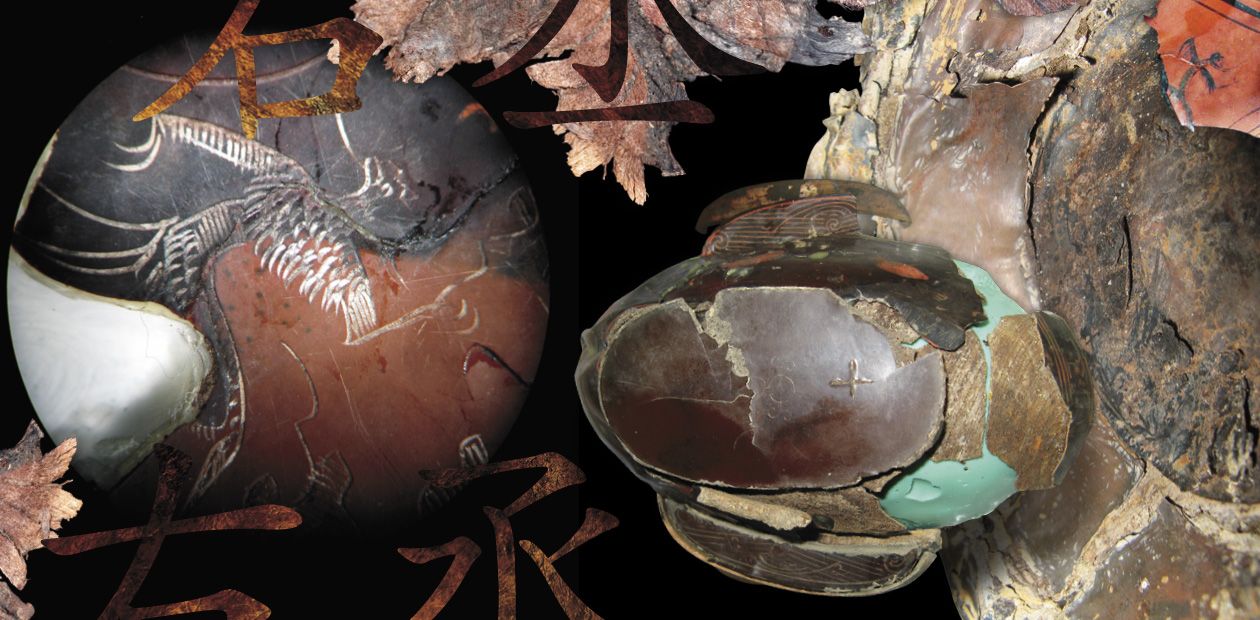Complete the Work of the Heavens
During the excavation of the Xiongnu kurgans in Noin-Ula, northern Mongolia, most singular Chinese artifacts covered with lacquer were discovered. This collection includes fragments of coffins, details of chariots and a variety of household items, including cups with inscriptions. Looking at these findings, you can understand why the main Chinese Encyclopedia of Technology, issued in 1634, bears the name “Discovering things through the work of the heavens”
The lacquer-coated objects were first discovered in 1924—1927, in the graves of Xiongnu nomads, during the excavation performed by the expedition of the famous traveler and scholar P.K. Kozlov. Almost 80 years later, his collection was enriched with the findings made by the Russian-Mongolian expedition (Polosmak et al., 2008, 2009).
Among a great many lacquer artifacts, the er bai lacquer cups with hieroglyphic inscriptions hold a special place.
The er bai – an elliptically shaped shallow cup (a little bowl), with two flat ear handles – was the most widespread type of lacquer vessels during the Zhou, Qin, and Han periods and the principal and universal item of tableware. According to S. Umehara (1960), this shape originated in South China and its prototype was a half-pumpkin. Most scholars believe that these cups were intended for wine, which is supported by the inscriptions like “Happy wine to you.” Some of the cups though bear the bands of characters reading “Cups for food” or “Happy food to you” (Hun Shi, 2006).
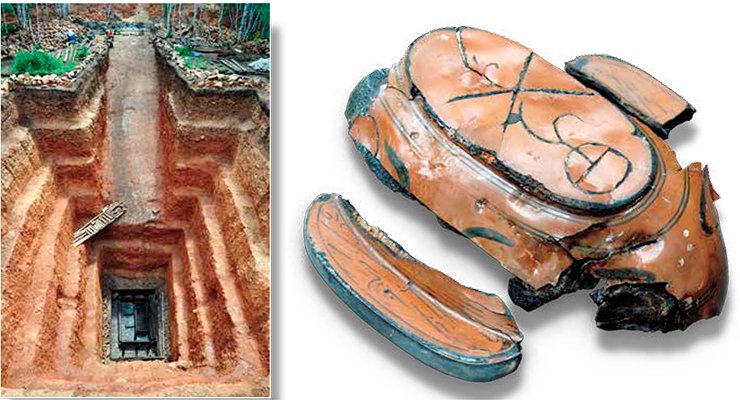
Lacquerware pieces rank among the most important inventions of ancient China, alongside with powder, paper and china, and they were the most expensive of all manufactured goods. Making lacquer objects took an incredible amount of time and work. It was a very high standard both of craftsmanship and technology: the surface of these fine pieces required up to two hundred separate lacquer coats, with several days drying time between them, meticulous polishing, followed by decoration and paining in finest hair-brush. The painting involved several procedures and was performed by different artisans. One craftsman gilded the cup handles, another polished and signed the piece.
Practicability, durability and beauty account for the high demand for lacquerware. In China, they lacquered shields and armor, sward scabbards and quivers for arrows, pikestaffs and chariot details, musical instruments and clay figurines, coffins, and many other things. Beauty was not the only answer though – back in the old times lacquer was valued because of its protective qualities: it was waterproof, heatproof and could even resist acids. The objects covered with lacquer were placed in graves during the burial ritual. In this case, they often indicated a high social status of their owners.
Both in the old times and in the Middle Ages, antiques including lacquerware were valued highly in China. For instance, a virtually indispensable ornament of a scholar’s study in the Late Middle ages was a cup covered with lacquer the color of “burnt purple” (Maliavin, 2003).
At the Han burial grounds, several hundred er bai cups have been found but outside China, such findings are quite rare. Within the territory in the range of influence of the Xiongnu Empire, the remains of the er bai cups were found, apart from the Noin-Ula tumuli, in Tamir 1 burials, Mongolia (Waugh, 2006); in Ilmovaya Pad’ burial, Trans-Baikal Region (Konovalov, 1976); and in Tumulus 57 of Yaloman II burial site, Gorny Altai (Tishkin, 2007).
The Noin-Ula collection of cups counts eleven artifacts, five out of them with inscriptions. The Russian-Mongolian archaeological expedition (organized in 2006—2012) discovered, in the 20th and 31st tumuli at Noin-Ula, five similar lacquer er bai cups and a saucer. The handles of the cups were reinforced with gilded metal coatings and decorated with geometric designs. The inside of the cups was painted red, and the outside was covered with black lacquer. The color of the lacquer depends on the pigment: cinnabar produced red color and soot made the lacquer black. The exterior of the cups was decorated with fine painting.
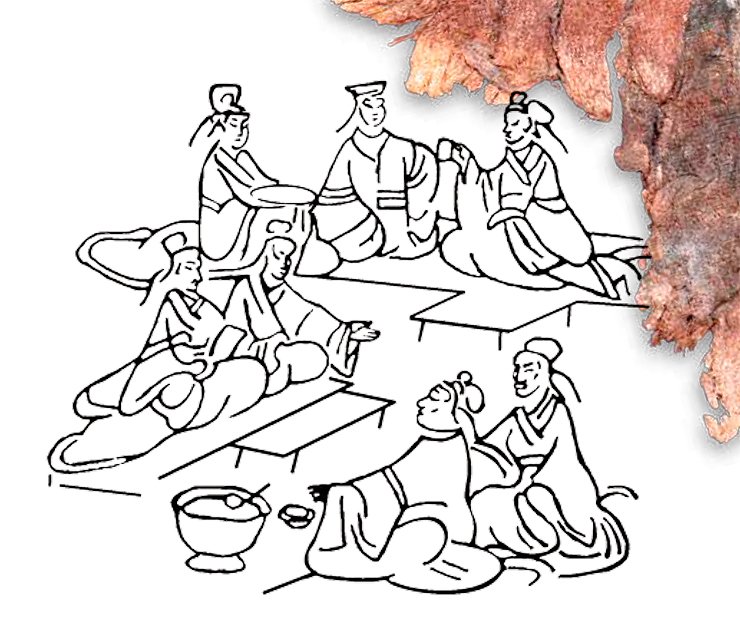
Every year, the Chinese delivered to the Xiongnu Chanyu 10,000 dan (200,000 liters) of rice wine (Collection of Evidence about the Peoples of Various Historical Epochs, Vol.1, 1958, Peking [in Chinese]). According to the calculations made by the historian N.N. Kradin (2002), if we assume the Xiongnu army to have 300,000 archers, there was more than 1.5 liter of rice wine daily for every representative of the Xiongnu top elite (from captain of the thousand on up because, according to the author, common warriors were not likely to be treated to the scarce goods). It is supposed that this amount of alcohol was intended to make the nomads drunk, and in this manner wine was one of the “temptations” with whose help Han China intended to demoralize the Xiongnu (Kradin, 2002).
It is more likely, however, that the wine, similarly to the other gifts of Han Emperors, was used by the chanyus to be given away in the Steppe during public festivals. For the nomads, who preferred kumis (fermented mare’s milk), it remained an exotic drink
It was these cups that Huan Kuan, the author of Discourses on Salt and Iron (1st c. B.C.), the most important source of knowledge about the Western Han ideology and culture, meant when he wrote, “For one lace oval cup you can get ten copper oval cups; their price is low whereas their use does not differ (from that of a lace cup)” (Huan Kuan, 2001, p. 87).
Time will tell
Before telling the story of these pieces, we should get to know how they were found. Similarly to all other organic items, lacquer objects do not fall into the hands of archaeologists in their original state: they should be competently extracted, preserved and, very often, correctly identified. Generally, it is at this stage that archaeologists “lose” the lacquer artifacts and make a record to the effect that traces of an unknown lacquer piece has been discovered. In those “lucky” cases when an item has been extracted from a burial but the necessary measures to conserve it have not been taken, the rare find decays irreversibly right before one’s eyes.
Handles of Chinese lacquer cups are decorated with metal mounts. Analysis conducted using the TM-1000 microscope with an X-ray fluorescence fixture has revealed their composition: high-tin (30%) bronze. On the face of the bronze, gilded “isles” can be seen. Judging by the presence of mercury (0.0016 %) in them, the gilding technique used was amalgamation.The mount was fastened on the cup’s wooden core with the help of a voluminous gluing material, which is now a light porous substance, very hard and strong, visually resembling a polymer. The results of infrared spectroscopy have shown that the gluing material is a mixture of lacquer and clay. The main property of this mixture is high adhesion strength.
The examination was conducted by Candidate of Chemistry S. S. Shatskaya (SB RAS Institute of Solid State Chemistry and Mechanochemistry, Novosibirsk)
Ancient lacquerware is considered to be strong; it preserves the original luster for centuries. However, this is not true for the archaeological findings. Exceptions are such phenomenal examples of organic matter integrity as the ones discovered in the burial chamber of Lady Dai (Early Han period, Mawangdui burial site, Changsha), where, thanks to complete air tightness, not only the lacquer but also the incorruptible body of the buried woman was well preserved. As for the majority of ancient burial sites, they only contain traces of once splendid lacquerware in the form of extremely thin bright scales, from which original artifacts cannot be reconstructed. Another problem with the discovery and extraction of lacquerware from a pit is the fact that very often an artifact covered in lacquer preserves only the lacquer coat, which, unless appropriate measures are taken in due time, winds itself into a tight tube. If this happens, the unique object is lost forever.
The integrity of the lacquerware found in the burial chambers of Noin-Ula tumuli was materially affected by two factors. The first is the damage done to the burial structure by robbers, and the second is the water that penetrated the burial chamber. As a result, the lacquer cups and other lacquerware found in the interior of the burial chambers of Tumuli 20 and 31, Noin-Ula, were partially ruined. The cups were disformed: they became flatter, partly disintegrated, and lost their handles. The wooden core under the lacquer swelled in the water, and the lacquer, being not a plastic substance, began to peel off. The lacquer’s chemical resistance was not affected though. Moreover, the humid environment, low temperature and absence of ultraviolet radiation contributed to the preservation of the lacquerware in its original glow, such as the red and black lacquer cover of a dish with an inscription, depicting Xians, winged celestial beings, and mythical animals; and fragments of the lacquer coat of a small artifact with the depictions of animals, a ram and a reindeer fawn.
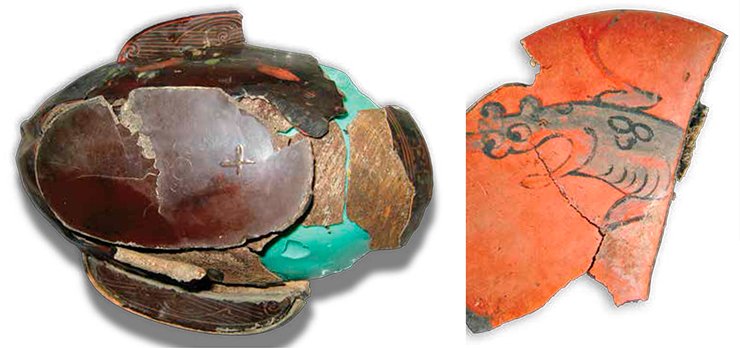
When the cups were unearthed from the tombs, the paintings on them could be clearly seen. Although the cups were kept in the conditions of high humidity and absence of sunlight, in six to eight weeks after the discovery the bright, intense color of the lacquer appeared to become dim – the inscription and the cover of the lacquer cups grew brownish. The reason was ultraviolet radiation that affected the artifacts during their restoration; together with high humidity, it had a strong destructive effect on lacquer (Webb, 2000). The subsequent preservation of the “wet” lacquers from the Noin-Ula tumuli required for special methods to be developed (Simonov, 2000).
The composition of the lacquer was studied using the techniques of infrared spectroscopy and chromate-mass spectroscopy by the researchers of the Laboratory of Physical Methods, Institute of organic Chemistry, SB RAS (Novosibirsk). It has turned out that all the samples of the lacquer had a similar composition. They all had dehydroabetic acid, contained in various quantities in virtually all resins produced by pinaceous conifers. In the lacquered films, its source was rosin. The samples also displayed a high content of palmic, stearic, oleic and other fatty acids indicative of the oil base of the lacquer.In the East, they mostly made lacquer from China wood oil and the sap of lacquer tree. However, the analysis of the lacquer from the Noin-Ula tumuli did not confirm the widespread opinion that the Han lacquer had been made on the basis of the sap of lacquer tree. It must have been used in China in later epochs
The initial fragmentary nature of the findings enabled the researchers to see and study the wooden and lacquer core, usually hidden under the top-coat lacquering, and to work out how the metal fixtures had been fastened on the handles. Another source of important information was the finely engraved hieroglyphic inscriptions, deciphered by Agniya N. Chistyakova (Chistyakova, 2009, 2011).
Responsible for the quality
One of the most outstanding events in the history of the Han Dynasty was the development of special regulations for the artisans working in state-run workshops (Elisseeff V. and Elisseeff D., 2007). The empire was concerned about establishing a strict hierarchy, which was reflected in the inscriptions made on lacquer cups.
The hieroglyphic inscriptions were made in the lower part of the cups, running around the base. The hieroglyphs, all of the same size, were exquisitely engraved. The inscription is hardly visible – it is a miracle and a great piece of luck that the wafer-thin lines of the hieroglyphs have preserved at all.
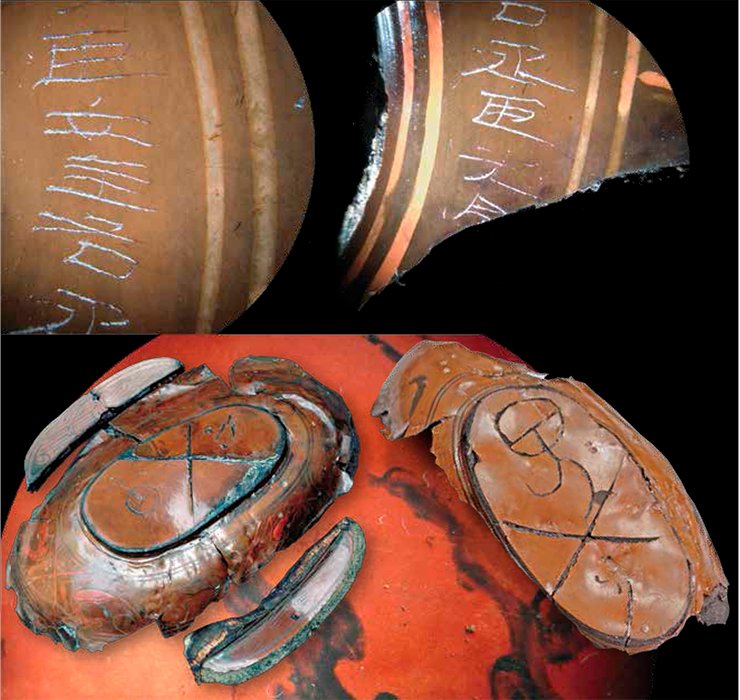
The inscription on a cup found in Tumulus 20comprised 46 hieroglyphs: 乘輿髹シ月畵木黄耳一升十六籥棓元延四年考工二[工]通繕シ月工憲守佐臣文嗇夫臣勳掾臣文臣 右丞臣光 令臣譚省。
The translation reads as follows: “[For] the imperial court a bai cup, with an inscription and ornament, has been made and lacquered. [The core] is wood, with yellow ears. The volume is 1 shen and 16 yue. In the 4th year Yuanyang, in the Kaogun workshop, restored (improved) by [craftsman] Tun. The inscription made (or the red-lacquer ornament made) [by master] Xian. In charge were deputy [junior officer]-zocheng Veng, [supervisor]-sefu [named] Hsun. Supervised by [assistant]-yuan Veng, [right assistant to the district head]-yuchen Huan, [head of the district office]-lin Tan.”
Another cup was heavily deformed, and the inscription contains only 11 hieroglyphs that have preserved and half of the chen hieroglyph臣: [掾]臣孝主守右丞臣忠守令臣畵省. Though the first part of the inscription is missing, the typical list of official posts (右丞 yuchen – the right assistant to a piece of work, 令 lin – a clerk), and the presence in the inscription of the hieroglyph 臣 chen – a servant and the final hieroglyph 省 shen – to control) suggests that the hieroglyphic structure of the inscription was similar to the previous one and that both inscriptions were made in the workshop of Kaogun based in Chanyani, the empire’s capital.
The translation of the inscription: “In charge were [assistant]-yuan Syao. Supervised by the representative of the [right assistant to the district head]-yuchen Chzhun, a representative of [the district office head]-lin Khua”.
The cup from Tumulus 31, Noin-Ula, also has slivers and cracks but the inscription has preserved almost completely:
乘輿髹シ月畵木黄耳一升十六籥棓元延四年考工二[工]相造 シ月工憲畵護臣隆守佐臣文嗇夫臣勳令史臣囗 掾臣文主右丞臣光 令臣囗省.
“[For] the imperial court a bai cup, with an inscription and ornament, has been made and lacquered. [The core] is wood, with yellow ears. The volume is 1 shen and 16 yue. In the 4th year Yuanyang, in the Kaogun workshop, made by [craftsman] Xian. In charge were the [scribe]-hu Lun, deputy [junior officer]-zocheng Veng, [supervisor]-sefu [named] Hsun, [head of the office]- 囗 linshi , [assistant]-yuan Veng. Supervised by [right assistant to the head of the district]-yuchen Huan, [head of the district office]- 囗 lin.”
Judging by the inscriptions on the cups, they had a wooden core, which was confirmed when their cross-sections were examined. Since all the three cups have the same legend (“Yuanyang, 4th year”), the year when the cups were made was determined (9 BC). Moreover, all these cups were made in the Kaogun Imperial workshop in Chanyan. In the light of these data, it is safe to say that the lacquer vessels discovered in the two Noin-Ula tumuli had arrived in the Steppe at the same time, as a gift of the Imperial court to the Xiongnu chanyu (ruler), who presented some of these precious items to a close relation.
The three cups have the same volume: 1 shen and 16 yue (approximately 340 milliliters). However, the comparison of the sizes of the cups has showed that they are different. Probably, it was the volume indicated and not the actual one that mattered. The point is that the symbols of volume and holding capacity were very important both in the philosophical tradition and in religion. For example, essential for Chinese ritualism was a measure of grain, indispensable for the households. This container of a conical shape symbolized the measure of world harmony, the absoluteness of being and the dipper of the Polar Constellation (called the “North Measure” in Chinese) (Malyavin, 2003).
The inscriptions give the names of those who made the cups and supervised the work – the two well-preserved cups have seven and nine names, respectively. If we compare the hieroglyphs denoting the names of the artisans who made the cups and the officers who supervised the production, we can see that they coincide with one exception: one of the cups was made by master Tun, and the other, by Xian. These inscriptions made on the artifacts of the same type, produced in the same year in the same workshop and having the same legend concerning the rule display a lot of coincidences among the hieroglyphs signifying the names of craftsmen and officers. In different years, the personalized hieroglyphs of the officers often differ: in Han times, the officers supervising the lacquerware workshops were replaced every year or every two years. (Zhang Rong, 2005). Judging by the inscriptions on the Noin-Ula cups, the number of officers who controlled the lacquerware production could differ.
The outer surface of the cups from the 20th Noin-Ula tumulus shows four pairs of phoenixes pained in red and in white. Phoenixes are also depicted on one of the cups from Tumulus 31. Depictions of pairs of phoenixes are typical of the bai cups; they often occur on the artifacts found on the territory of China. At the time of the Han Dynasty, the phoenix was an imperial symbol or a symbol of belonging to the Imperial court; the emperor himself was referred to as the phoenix. In written sources, the symbol “phoenix” acquired the meaning of the “empress” or a “woman connected with the emperor.” This is why it is no coincidence that the depictions of this bird are present on the items made for the emperor’s court, and it is not incidentally that they made part of the regular gifts bestowed by the emperor’s court on the Xiongnu to buy peace on the state border.
Ownership marks
Scribed on the bases of the lacquerware from the 20th and 31st Noin-Ula tumuli are strange graphic signs. They are identical for one burial but differ from tumulus to tumulus. What these signs have in common is the circle crossed in the center with different combinations of the same elements. What do they all mean?
The word “tamga” of Turkic-Mongolian origin has several meanings: a brand-iron, a seal, a stamp. Basically, the tamga consists of simplest geometrical figures though sometimes it has the depictions of animals, birds or objects. This is a mark of ancestral or tribal ownership, a kind of a signature.
“HE GIVES HER CARVED CARPS” The burial chamber of the 20th Noin-Ula tumulus concealed a remarkable artifact that was decorated using an inventive technique – a wooden lacquer imitation of a fish.The fish is 31.0 cm long; the maximum width and thickness of the body are 8.0 and 0.5 cm, respectively. On the tail, some fragments of red lacquer can be seen. The decoration of the head and middle part of the body is outstanding. It is fish skin covered by a film of colorless lacquer. The base of the skin is the ground coating of wood and woven fabric – the structure of cloth is visible on the micrograph of the skin’s surface. L. A. Koneva, A.P., Chair of Zoology, Novosibirsk State Teacher Training University, proposed that judging by the shape of the scales’ traces, the scale was cycloid, which suggests that a carp-like fish (Cypriniformes) of the cyprinoid fishes (Cyprinidae) was used.
The collection of the Japanese Emperor Shōmu (724—748), kept in the treasure house in the city of Nara, is known to contain Chinese musical instruments encrusted with sturgeon scale sunk into the wet lacquered coating in the process of making the instruments. To make the ornament of the scale more conscicuous, the upper layer of lacquer, after drying, was thinned down through polishing (Kravtsova, 2004).
The purpose of this unique artifact may be related to the well-known Chinese tradition of putting messages written on silk scrolls into the tablets carved in the shape of a carp. For example, the Yuefu ancient folk song that concerns the parting of spouses (the husband was sent to build the Great Wall) goes as follows:
And nobody brings a letter to her!
Here is a wanderer from far-away lands –
He gives her carved carps.
She calls for her sons to untie the package,
In it is a letter for her on silk.”
(Lisevich, 1984, p. 297)
It was the tamgas – signs of Xiongnu ownership – that were scribed on the bases of all lacquer cups and dishes discovered by our expedition in the Noin-Ula mounds. The way they were made – using a sharp object, sometimes preheated on fire, confirms that they belong to the Xiongnu. The scribed lines literally break the lacquered surface to the wooden base. The craftsmen Tun and Xian would not have approved...
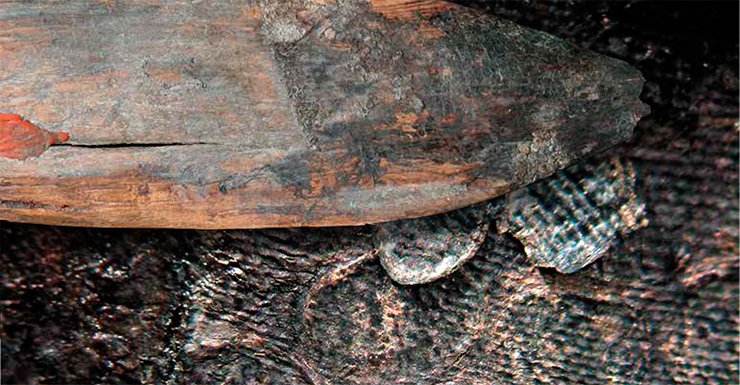
Some of the tamgas, however, were neatly scribed on the lacquered surface with a sharp needle. Signs or marks (a sidelong cross, a hieroglyph) made in the same manner were discovered earlier on the bases of some er bai cups unearthed from the Han burials in Hubei Province. They are hardly visible and were made in the same way as the hieroglyphic inscriptions produced in workshops. Chinese archaeologists believe that these were the marks of the masters.
Finely drawn tamgas were found on the lacquerware from the 31st Noin-Ula tumulus, where the woman was buried. These marks could have been made by her. At least, the original graphic mark found on three lacquered objects from this tumulus – a crossed circle with “whiskers” radiating from it and a small depiction in the shape of a cross (possibly, a reduced representation of a bird) – must have been the personal brand of their owner. Another sign present on one of the cups alongside the aforesaid mark – a circle decorated with new, sophisticated elements – could have been the tamga of her husband.
The bases of three er bai cups from Tumulus 20 show, on top of a crossed circle with curved lines radiating from it, a stylized figure of a bird. In this case, the bird could have been the clan tamga of one of the owners of the cup. On two cups, there is also a sidelong cross in the center, across the base. The mythology of many peoples identified the cross with the universe, the cardinal points, which symbolized the origin of life and fire.
On the base of the lacquered cup from Tumulus 6, Noin-Ula, discovered by Kozlov’s expedition, there are shanglin hieroglyphs painted in red lacquer, denoting the name of the emperor’s park and palace. This is probably why the Xiongnu tamga (a scribbled stylized depiction of a bird) was made on the metal surface of the cup handle. Carved on the base of one of the cups from Tumulus 23, Noin-Ula, (also from the materials of Kozlov’s expedition) was a tamga in the form of a circle with two curly lines going from it (from a single point). Roughly drafted graphic depictions can be seen on the fragments of a cup base from Tumulus 1 of Tsurumte burial ground (diggings by A.D. Simukov, 1927), also making part of the Xiongnu barrows in Noin-Ula.
Another curious Xiongnu tamga was discovered on the elite burial site in Tumulus 7 of Tsaram burial ground (Transbaikalia, excavations by S.S. Minyaev, 2007). In this case, it was made on the base of a birch-bark container. The basis of this tamga is also a circle with additional elements. Interestingly, the tamgas from this and the four Xiongnu tumuli of Noin-Ula (6, 20, 23 и 31) are very similar but not identical. The differences must be attributed to the individuals buried in the tumuli. Judging by ethnographic materials, personal tamgas developed from a common mark, preserving its main outline and varying only in details (Simchenko, 1965).
It should be mentioned here that until recently Xiongnu tamgas have been virtually unknown, though there was an idea that the signs made on the petroglyphs found in Eastern Mongolia could have been tamgas (Dorjsuren, 1961). Indeed, the closest analogs to tamgas on the lacquerware from the Xiongnu tumuli can be seen on the petroglyphs discovered in Mongolia, though not in Eastern but in Western and Central Mongolia. In particular, the complete analogs were discovered at the Tsagan-gol site in South-Western Mongolia.
The researchers of petroglyphs link these tamgas with the Yuezhi, Iranian-language tribes neighboring on the Xiongnu. In its turn, the tamgas discovered on the cliffs of Mongolia have analogs among Sarmatian tamgas and the group of tamgas from Central Asia and North Black Sea region (Novgorodova, Vineberg, 1976). Recently, the hypothesis that the tradition of using tamgas came to the Sarmatians from Central Asia has been winning general recognition.
The territory of Mongolia did not use to be the ancestral habitat of the Xiongnu; they took over these lands, belonging to the neighboring tribes. Possibly, before coming here the Xiongnu did not have tamgas or other clan marks but, having settled in Mongolia, they began using the tamgas made on the cliffs by the previous proprietors as their own. In this situation, taking over property marks followed naturally from the invasion into a new area. One may speculate that Xiongnu high-placed clans used Yuezhi tamgas as the basis. It can just as readily be suggested though that the lacquerware and birch-bark containers discovered in Xiongnu tumuli bear their own marks because the Yuezhi appropriation of the tamgas found on the petroglyphs of South-Western Mongolia is not a well-established or a fully acknowledged fact. The new evidence suggests that all these depictions could have been made by the Xiongnu.
The Xiongnu Chanyu rulers originated from the clan of Luanti, related by marriage to the other four noble families: Huyan, Lan, Xubu, and Qiú-lin. It must be the tamgas of these clans of top Xiongny aristocracy that we can see on the lacquerware discovered at Xiongnu burial sites.Sometimes, lacquerware can be found in the graves of regular Xiongnu. This is attributed to the custom that a Chanyu, having an exclusive monopoly on receiving imperial gifts, gave away the Han presents to his fellow tribesmen, maintaining his reputation in the Steppe. For instance, the er bai cup painted with phoenixes with a hieroglyphic inscription was discovered in a woman’s tomb of the 58th burial of Ilmovaya Pad’ burial ground but the piece fell apart before the inscription was read (Konovalov, 1973). In the 50th burial of the same burial ground, two more lacquer cups were found, with the craftsman’s name carved on the base of one of them, according to P.B. Konovalov. Needless to say, this tamga has not survived either …
The hieroglyphic inscriptions and tamgas made on the lacquerware from the Xiongnu mounds at Noin-Ula illuminate the striking difference between cultures and civilizations. When you see an inscription made in neat lines in the most inconspicuous part of a lacquer cup listing nine people involved in manufacturing this precious object and then discover, on the cup base, a “signature” made by the new owner, who did not care a pin about preserving this exquisite beauty, it becomes obvious that no “temptations” of Han China could have made the nomads turn off their own way. The higher culture did not take roots in the Steppe because it was not vital there.
In this manner, the lacquerware miraculously spared in Xiongnu tumuli is the meeting place of two cultures, two worlds: the world of elegant things and philosophical ideas and the world of plain desires; the ancient civilization equal in power and glory to the Roman Empire and the civilization of nomadic warriors and cattle-breeders whose main occupation was warfare and who valued above all their own way of life.
References
Vajnberg B. I., Novgorodova Je. A. Zametki o znakah i tamgah Mongolii // Istorija i kul’tura narodov Srednej Azii. M.: Izd-vo «Nauka» Glav. red. vost. lit. 1976. S. 66—74.
Elisseeff D. and Elisseeff V., La Civilisation de la Chine classique Broché, Paris: Arthaud, 1993 (in French).
Kozlov P. K. Dnevniki Mongol’sko-Tibetskoj jekspedicii. 1923 –1926. SPb.: Nauka, 2003. 1039 s. (Nauchnoe nasledstvo T. 30).
Minjaev S. S., Saharovskaja L. M. Jelitnyj kompleks zahoronenij sjunnu v padi Caram // RA, 2007, №1. S. 194—201.
Polos’mak N. V., Bogdanov E. S., Cjevjejendzhordzh D. Dvadcatyj noin-ulinskij kurgan. Novosibirsk: INFOLIO, 2011. 184 s.
Umehara S., Mōko Noin Ura hakken no ibutsu. (Studies of Noin-Ula Finds in North Mongolia), Artibus Asiae Publishers, vol. 27, N 4, 1964—1965, pp. 365—369 (in Japanese).
Handai wuzhi wenhua ziliao tushuo (Illustrated explanations of the material culture of the Han Dynasty). Shanghai: Guji chubanshe, 2008 (in Chinese).
Hong Shi. Zhanguo Qin Han Qiqi Yanjiu (A Study on Lacquer Sets of the Warring States Period and the Qin and Han Dynasties). Beijing: Wenwu chubanshe, 2006 (in Chinese).
Zhang Rong. Gudai qiqi (Ancient Lacquer Ware). Beijing: Wenwu chubanshe, 2005. (Series: Ershi shiji zhongguo wenwu kaogu faxian yu yanjiu (Collection of Archaeological Studies and Discoveries of Chine of the 20th Century)) (in Chinese).
Shang Chengzuo. Changsha guwu wenjianji. Xuji (Record of Ancient Things Seen in Changsha. Continuation). Zhonghua shuju, 1996 (in Chinese).
Hong Shi. Productions and Management of the Lacquer Industry during the Warring States, Qin and Han Periods // Chinese Archaeology. 2006. Vol. 6. P. 152—158.
The photographs are the courtesy of M. Vlasenko, L. Kundo, and S. Zelenskiy
This work was conducted within the framework of a joint project of the Siberian Branch of the Russian Academy of Sciences, and the Academy of Sciences and Ministry of Education, Culture and Science of Mongolia “Restoration and examination of archaeological materials from Tumulus 22, Noin-Ula” (#01201374181)


